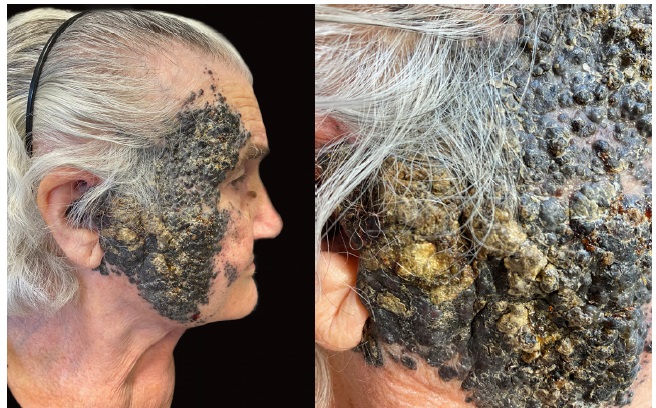
Journal of Clinical Images and Medical Case Reports
ISSN 2766-7820
Clinical Image - Open Access, Volume 2
A strange case of melanoma: An (in)visible enemy
Arianna Piccolo*; Ilaria De Simoni
Dermatology, Department of Systems Medicine, University of Rome Tor Vergata, Viale Oxford, 81 00133 Rome, Italy.
*Corresponding Author: Arianna Piccolo
Dermatology, Department of Systems Medicine,
University of Rome Tor Vergata, Viale Oxford, 81 00133 Rome, Italy.
Email: ari.piccolo91@gmail.com
Received : Sep 14, 2021
Accepted : Oct 20, 2021
Published : Oct 27, 2021
Archived : www.jcimcr.org
Copyright : © Piccolo A (2021).
Keywords: non-small cell lung cancer; immunotherapy; pulmonary immune related adverse events; radiation therapy.
Citation: Piccolo A, Simoni ID. A strange case of melanoma: An (in)visible enemy. J Clin Images Med Case Rep. 2021; 2(5): 1385.
Clinical image description
We report the case of a 91-year-old Caucasian female patient who came to our attention due to the appearance of a 10 X 15 cm plaque with irregular margins, with mammary appearance, strongly and variably pigmented, localized on the right hemiface after about 8 weeks.
Dermoscopic examination showed an aspecific pattern characterised by the presence of a variously pigmented background, with the presence of a blue-grey veil and overlapping of serum-hematous crusts.
There was no significant medical history and no significant objective data on general examination.
A biopsy was therefore performed, which revealed the presence of a melanoma, as demonstrated by the positive results for the S-100 and Sox10 markers. In addition, the search for the V-600E allele on the Braf gene was negative, thus excluding the possibility of performing a specific target-therapy for the mutation.
As per protocol, the patient underwent instrumental examinations, such as total-body CT-PET to assess the presence of locoregional and distant metastases [1].
First of all, although we do not have certain data on the rate of evolution of the lesion, its size makes it unique in its kind.
Consequently, as suggested by the literature, a therapeutic approach based on radio-chemotherapy or immunology would at least be desirable [2].
On the other hand, the age data cannot be overlooked in such a context, especially considering the patient’s good general state of health, despite the dermatological finding.
And it is precisely in cases like these that a holistic and multidisciplinary approach is necessary, in order to achieve a clinically effective but, above all, humanly acceptable management [3].
Funding sources: None
Conflict of interest: None declared for AP, IDS
References
- Ortega-Candil A, Rodríguez-Rey C, Cano-Carrizal R, Cala-Zuluaga E, González Larriba JL, et al. Breslow thickness and (18)F-FDG PET-CT result in initial staging of cutaneous melanoma: Can a cut-off point be established? Rev Esp Med Nucl Imagen Mol. 2016; 35: 96-101.
- Takahashi J, Nagasawa S. Immunostimulatory Effects of Radiotherapy for Local and Systemic Control of Melanoma: A Review. Int J Mol Sci. 2020; 21: 9324.
- Dunn J, Watson M, Aitken JF, Hyde MK. Systematic review of psychosocial outcomes for patients with advanced melanoma. Psychooncology. 2017; 26: 1722-1731.

